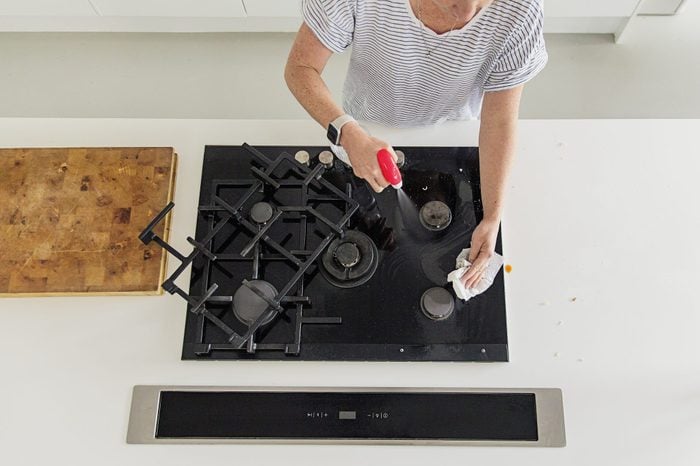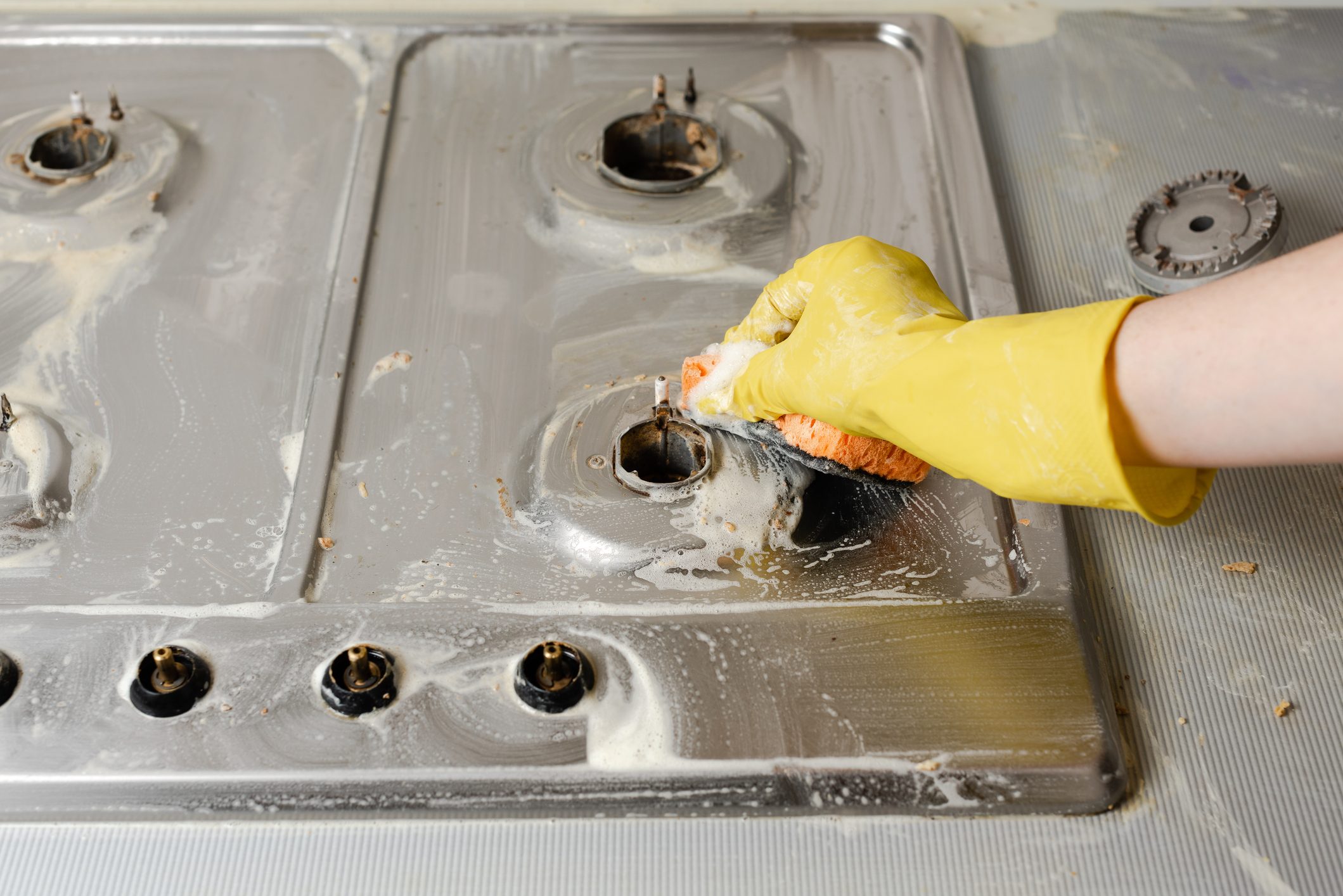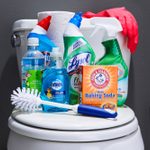How to Clean Your Stovetop and Get Rid of Grease

Still have last week's dinner splattered on your stovetop? Don't worry—here's how to get rid of that gross gunk in no time.
Our editors and experts handpick every product we feature. We may earn a commission from your purchases.
We’ve all been there before. We’re cooking dinner on the stovetop and, suddenly, something boils over or splatters all over the place. Messes like this happen in the kitchen, but if they aren’t taken care of properly, they can cause unsanitary (and embarrassing) buildup on your stovetop. It’s essential to know how to clean household appliances like your microwave, oven, and stovetop because you use them so frequently. The stovetop is especially important, though, since neglecting to clean it can cause some serious problems—and people will also definitely notice if it’s dirty. Here’s how to clean your stop top effectively and get rid of those unsightly messes quickly.
On This Page
Why is it important to clean your stovetop?
You should clean your stovetop because it’s an area that sees a lot of traffic—and splatter. “Cleaning your stovetop is important because it is an area of your kitchen that is most prone to grease, food grime, and bacteria buildup,” says Johnny Pallares, owner of De La Rosa House Cleaning.
It’s also important to disinfect your stovetop, especially if you’re cooking with items like raw chicken. If you don’t clean your stovetop, you could spread the bacteria and germs that come from the items you’re cooking with. Cleaning your stovetop will make your kitchen cleaner and reduce the chance of someone falling ill. It’s embarrassing to have company show up unexpectedly and see your messy stovetop, so be prepared to scrub quickly and know how to clean your kitchen fast.
What happens if you don’t clean your stovetop?
If you don’t clean your stovetop, food and oil will build up on its surface. The longer that buildup sits, the harder it will be to clean down the road. Plus, this buildup can leave unpleasant stains on your stovetop. “Every time you use your stovetop to cook, small amounts of food, oil, dirt, and grime begin to build up atop it and form stains,” says Cyrus Bedwyr, an oven cleaning specialist at Fantastic Services. “With time, these stains will become quite noticeable.” If you don’t know how to remove stains like these, they could easily become eyesores.
You could also damage your stovetop and reduce its life span by not cleaning it. “Depending on what type of stove you have, if you don’t clean your stovetop frequently, grease can build up around the coils and burners and impact the life span of your appliance,” Leanna Staph, Chief Operating Officer of The Cleaning Authority, explains. The average life span of home appliances varies, but one thing is certain: You want to keep your stovetop properly working for as long as possible, and cleaning it will help it last longer.
Pallares adds that not cleaning your stovetop can also be a fire hazard. “A stovetop with large amounts of food and grease buildup can cause that leftover food to burn and can cause a kitchen fire.”
How often should you clean your stovetop?
How often you should clean your stovetop depends on how often you use it. “Someone who cooks once a week may only need to clean it once a month,” Pallares explains. “However, a family of four that cooks five to seven days per week should clean their stovetop at least once a week.”
If you’re worried about grease and food building up on your stovetop, you can always do a quick cleanup after each use. Just make sure the stovetop is cool before you wipe it down.
How to clean a glass stovetop
Knowing how to clean your stovetop is essential, especially if you have a glass stovetop. Bedwyr says the following procedure is a great way to make your glass stovetop shine.
What you’ll need:
- A bowl
- Microfiber towel (big enough for the entire stovetop)
- Non-abrasive scrubbing pad
- Dish soap
- Baking soda
Directions:
- Wait until your glass stovetop is cold—never clean on a hot stovetop.
- Fill a bowl with warm to hot water, and add a few drops of dish soap. Mix well until you’re left with a sudsy mixture.
- Submerge an entire microfiber towel into the mixture; wait until it becomes saturated.
- Add a thick layer of baking soda over your glass stovetop.
- Take the towel out of the soapy water and wring it out. Then, lay it over the baking soda, and let it sit for around 30 minutes.
- Once time is up, scrub the stovetop in a circular motion using the non-abrasive scrubbing pad.
- Use a clean, dry microfiber towel to remove remaining water or baking soda residue from the stovetop.
- Be extra careful when using the non-abrasive scrubbing pad, as you don’t want to leave scratches on the glass.
How to clean a gas stovetop
If you have a gas stovetop, Staph recommends the following process for cleaning it properly.
What you’ll need:
- Cloth
- Non-abrasive sponge
- Dish soap
- Baking soda
- Vinegar
Directions:
- Make sure the stovetop is cool and turned off before cleaning.
- Wipe down the stovetop with a damp cloth.
- Wash the entire surface area with a non-abrasive sponge and dish soap.
- If the surface is too greasy, utilize a 1:2 baking soda and vinegar mixture, and let it sit before wiping it off. You can use this same tactic on the burners.
- Dry the stovetop with a clean cloth, and replace the burner heads.
All that grime and grease will be gone before you know it!
How to clean an electric stovetop
If you need to clean your electric stovetop (don’t forget the coils!), Bedwyr says the following cleaning routine will make your stovetop look as good as new.
What you’ll need:
- Cleaning cloth
- Dish soap
- Baking soda
Directions:
- Make sure the stovetop is completely cool and turned off before you begin cleaning.
- Put a bit of dish soap on a damp cleaning cloth, and use it to wipe dirt off the coils.
- For stubborn dirt and grime, make a cleaning paste out of baking soda and warm water.
- Rub the baking soda paste over the persistent stains, and let it sit for around 30 minutes.
- Use a wet cloth to scrub the paste and dirt away.
- Dry the stovetop with a clean, dry cloth.
- Let the stovetop dry completely before turning it on again.
Things you shouldn’t use to clean your stovetop
Cleaning experts recommend staying away from cleaning products that have a large amount of chemicals when cleaning your stovetop. “Stick to natural products,” Staph says. “Baking soda is effective at eating away stuck-on foods and stains.”
Bedwyr says to avoid using scrubby sponges and steel wool when cleaning a glass stovetop, as they can leave surface scratches and deep crevasses in the glass’ surface.
How to keep your stovetop clean
Consistency is key when it comes to keeping your stovetop clean. “A quick daily clean goes a long way in keeping a happy and healthy kitchen,” Pallares says. “I also recommend checking the edges of your stove and cleaning there. This area is missed frequently, and old food and grease can easily build up in there.” He also recommends cleaning your oven once every three months to keep it sanitized and running smoothly.
If you see a mess on your stovetop, wipe it up quickly if you can. It’ll save you some cleaning hassle down the line, and it will keep your kitchen looking tidy. P.S.—if you’re looking for a powerful cleaner, check out The Pink Stuff. It’s a total game-changer!
Expert Sources:
- Johnny Pallares, owner of De La Rosa House Cleaning
- Cyrus Bedwyr, oven cleaning specialist at Fantastic Services
- Leanna Staph, Chief Operating Officer of The Cleaning Authority



